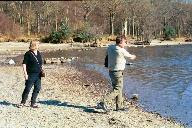Theory is that J will go for overdue haircut (length only somewhat disguised by curls) and then meet me at 10 at the tourist information building for the walking tour of Larnaca. Haircut doesn't materialize due to surprising length of queue. So we meet at the tourist information and debate whether we actually want to go - settled by my saying yes to a woman who demands to know whether we're there for the walk.
It's not bad, overall. Led by a woman with copper coloured nailpolish and an engaging style, though a tendency to rhetorical questions, of the sort one feels silly either answering or looking like one doesn't know the answers to, and a habit of exaggerated repetition. Probably occupational hazards. It's a pretty international group - a Russian couple, a Finn, a Mexican man, a Peruvian girl, and a tall American from LA who has been travelling the world for a year and a half and has just landed here yesterday. Not horrifically political, although we do hear that the Turkish Cypriot North has left the city of Famagusta totally empty as a bargaining chip - imagine, she repeats it twice, the whole city. There is a vacant area of no access, but scarcely the whole city. We've been to Famagusta more than once, and indeed some of the others may have gone as well, as it's easy to book tours from the south, which makes the whole rhetoric somewhat ridiculous.
The tour heads along the waterfront and then up into the workshop area. On the street where carpentry and metalwork shops are side by side we see two enormous stills, one of them copper. Stills are used for distilling zivania, the local version of schnapps, and, more surprisingly, rose water, a standard ingredient in Cypriot baking. round the corner is a shop where the wool-like stuffing from flax is used to fill pillows and mattresses, made by the last artisan of his kind locally.
And another veteran craftsman across the road makes very specialized wax images, to be used as votive offerings. In the shape of various organs and limbs, or even babies, they are made to present at church as an accompaniment to prayers for recovery from illness or for the birth of a child - and seem to have a history that goes well back into pagan times. Apparently a woman praying to have a child will, if successful, name the infant after the patron saint of the church where the prayers were made. which would make one wish to choose the church with care, avoiding, for example, St Lazarus (which is on our route) and looking for a St Michael or St John in its place. The old man who makes the images is 94 and looks much younger. He's asked for the secret of his successful aging and says that he eats sparingly, mostly fruit and vegetables with very little meat, hardly drinks alcohol, and is never jealous or angry. Even at 94, he's good-looking and on the wall is a large poster showing the son who has inherited the family talent for music (father is a violinist) and is a professional singer in Greece with a remarkable resemblance to Elvis.





